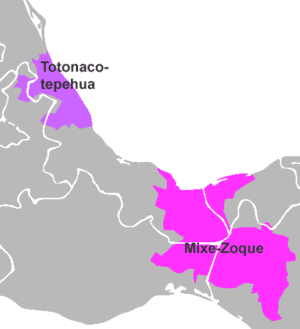Totozoquean languages
Totozoquean (Toto-Zoquean) is a proposed language family of Mesoamerica, originally consisting of two well-established genetic groupings, Totonacan and Mixe–Zoque. The erstwhile isolate Chitimacha was later proposed to be a member. The closest relatives of Totozoquean may be the Huavean languages.[1]
Correspondences
Comparative proto-Totozoquean reconstructions are proposed in Brown et al. (2011) for simple consonants and vowels. The consonant-inventory for proto-Totozoquean is similar to that reconstructed for proto-Totonacan (Arana Osnaya 1953), and the vowels are not unlike those proposed for proto-Mixe–Zoquean (Wichmann 1995). A parallel set of laryngealized but otherwise identical proto-Totozoquean vowels is reconstructed for proto-Totozoquean to account for the distribution of laryngealized vowels in the Totonac branch of the Totonacan family, though these left no known trace in proto-Mixe–Zoquean (Wichmann 1995) and there may be a more economical explanation. Vowel length is likewise an independent parameter reconstructed for proto-Totozoquean that does not seem to affect the correspondences, but in this case it is a feature inherited by both families.
- Vowels
Proto-Totozoquean (pTZ) is reconstructed with seven vowel qualities, all of which occur with long, laryngealized, and long laryngealized homologues. These reduce to a three-vowel system in proto-Totonacan (pT); length and laryngealization is retained. Proto-Mixe–Zoque (pMZ) loses laryngealization and neutralizes **ɨ~ə and **ɔ~o.
| pTZ | pT | pMZ |
| **i | *i | *i |
| **e | *e |
| **ɨ | *ə |
| **ə | *a |
| **a | *a |
| **ɔ | *o |
| **o | *u |
| **u | *u |
- Consonants
Of the three consonants which do not appear in either daughter, **ty and **ny are poorly attested, whereas **ky is robust. Proto-Mixe–Zoque loses the laterals and gutturals, and neutralizes the alveolar–palato-alveolar distinction. Proto-Totonocan loses glottal stop and **y.
| pTZ | pT | pMZ |
| **n | *n | *n |
| **ny | *l |
| **l | *y |
| **ɬ | *ɬ |
| **ƛ | *ƛ |
| **y | *t |
| **t | *t |
| **ty | *č |
| **č | *¢ |
| **¢ | *¢ |
| **š | *š | *s |
| **s | *s |
|
| pTZ | pT | pMZ |
| **p | *p | *p |
| **m | *m | *m |
| **w | *w | *w |
| **ky | *k | *k |
| **k | *q |
| **q | *ʔ |
| **ʔ | *∅ |
| **h | *h |
| **#h | *h |
| **x | *x |
|
See also
References
- Arana Osnaya, E. 1953. Reconstrucción del protototonaco: Huastecos, totonacos y sus vecinos, ed. Ignacio Bernal. Revista Mexicana de Estudios Antropológicos 23:123–30.
- Brown, Cecil H., David Beck, Grzegorz Kondrak, James K. Watters, and Søren Wichmann (2011). Totozoquean. International Journal of American Linguistics 77, 323–372.
- Brown, Cecil H., David Beck, Grzegorz Kondrak, James K. Watters, and Søren Wichmann (2011) "Linking proto-Totonacan and proto-Mixe–Zoquean"
- Søren Wichmann (1995). The Relationship among the Mixe-Zoquean Languages of Mexico. Salt Lake City: University of Utah Press.
|
|---|
| | Mixe | Oaxaca Mixe | |
|---|
| Gulf Mixe | |
|---|
| Chiapas Mixe | |
|---|
|
|---|
| | Zoque | Oaxaca Zoque | |
|---|
| Chiapas Zoque | |
|---|
| Gulf Zoque | |
|---|
|
|---|
| † – Extinct. |
|
|
|---|
| | Demonstrated families | |
|---|
| | Isolates | |
|---|
| | Proposed macrofamilies | |
|---|
| | Linguistic areas | |
|---|
|
- ↑ Brown, Cecil H., Wichmann, Søren, & Beck, David. 2014. Chitimacha: A Mesoamerican language in the Lower Mississippi Valley. International Journal of American Linguistics 80(4): 425–474.
